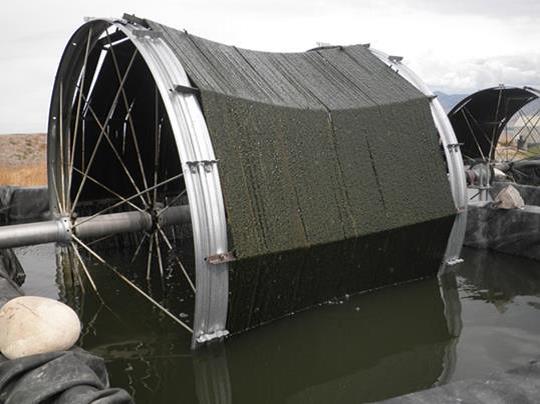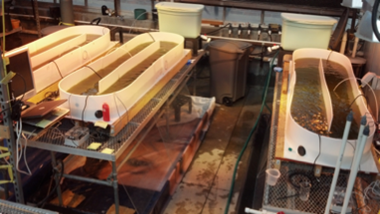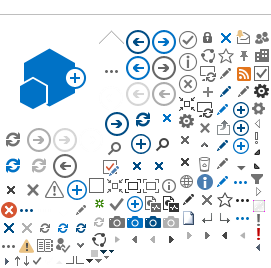Dairy farms have historically spread nutrient-rich manure on agricultural fields, and the result is nutrient overloading, which has serious production and environmental impacts. In the context of integrated dairy manure management, algae can serve as a source of biomass while serving as a sink for some of the excess nutrients produced in the rest of the process. The biomass can be fed into the fermenter to increase yields from the fermenter and, by extension, increase yields of the desired products. Carbon dioxide can be diverted from anaerobic digester biogas to serve as the carbon source for algae growth. Some of the nitrogen- and phosphorus- rich effluent from the anaerobic digester or PHA reactor (or some combination of the two) will be input into the algae reactor to stimulate growth.
Both detached and attached growth scenarios for algae production are considered in the DAIRIEES model. There are two main methods for
detached growth microalgae production: photobioreactors (PBRs) and open raceways. For the
attached growth scenario, the Rotating Algal Biofilm Reactor and the algal turf scrubber were examined.
Attached Growth Systems
Rotating Algal Biofilm Reactor
 The rotating algal biofilm reactor (RABR) is an attached algae technology developed at Utah State University.1 The RABR has been shown in previous studies to reduce the total nitrogen concentration in municipal wastewater and simultaneously generate algal biomass and associated bioproducts. Preliminary results from laboratory-scale studies indicate that the RABR technology will be viable in dairy and agricultural wastewater and USU is currently optimizing the RABR technology at their pilot-scale site at the USU Caine Dairy Teaching and Research Center.
The rotating algal biofilm reactor (RABR) is an attached algae technology developed at Utah State University.1 The RABR has been shown in previous studies to reduce the total nitrogen concentration in municipal wastewater and simultaneously generate algal biomass and associated bioproducts. Preliminary results from laboratory-scale studies indicate that the RABR technology will be viable in dairy and agricultural wastewater and USU is currently optimizing the RABR technology at their pilot-scale site at the USU Caine Dairy Teaching and Research Center.
Algal Turf Scrubber
 The algal turf scrubber (ATS) treatment technology consists of an attached algal community growing on screens in a sloped trough over which AD effluent flows.2 The key variables that affect the metabolism of the algal community are water depth and flow rates, presence of grazers (i.e., herbivores) and harvest frequency (which rejuvenates the organisms and increases growth rates). The attached algal community uptakes inorganic compounds and breaks down organic compounds.
The algal turf scrubber (ATS) treatment technology consists of an attached algal community growing on screens in a sloped trough over which AD effluent flows.2 The key variables that affect the metabolism of the algal community are water depth and flow rates, presence of grazers (i.e., herbivores) and harvest frequency (which rejuvenates the organisms and increases growth rates). The attached algal community uptakes inorganic compounds and breaks down organic compounds.
Detached Growth Systems
Photobioreactors
PBRs are closed vessels and, since the environment is artificial, all the operational variables are controlled. Though these systems sometimes have higher yields because the system can be better optimized, this additional control is accompanied by increased capital and maintenance costs.
Algae Raceways
The main purposes of the algae raceways are to sequester carbon by growing algae and to uptake excess nutrients from the rest of the process. Carbon dioxide, light, water, and a nutrient source are needed for the algae to thrive.
A raceway is a series of long oval “tracks” around which the water, which contains the suspended algae, slowly move. The raceway is open on top, allowing for the necessary sunlight to reach the algae. Carbon dioxide is bubbled in, and water is pumped in order to replace water that has evaporated. Usually a paddle wheel is used to keep the water-algae mixture moving. At regular time intervals, the algae are harvested. A certain amount of algae/water is removed, and the algae are allowed to settle out of the water. This mass of algae, which is rich in carbon, is then used as a source of carbon for the fermenter. Harvesting the algae also serves to make sure that the raceway does not get overcrowded so the necessary amount of light is always available for algae growth.
 Full-scale raceway algae raceways are open to the elements. They only operate when there is sunshine since the algae require light to grow, so using electricity for pumping at night is a waste. Excess water is necessary to make up for the water that is lost to evaporation. Some of the operational concerns for a raceway are the amount of fertilizer/nutrients added, temperature, and the frequency with which the algae are harvested.
Full-scale raceway algae raceways are open to the elements. They only operate when there is sunshine since the algae require light to grow, so using electricity for pumping at night is a waste. Excess water is necessary to make up for the water that is lost to evaporation. Some of the operational concerns for a raceway are the amount of fertilizer/nutrients added, temperature, and the frequency with which the algae are harvested.
There is another beneficial byproduct of the algae harvesting. In addition to the carbon-rich solids that are removed to add to the fermenter, there are other solids produced that are rich in nitrogen and phosphorus. These solids can be sold as biomass for fertilizer, creating a value-added product for the user to sell, which contributes to making the overall process more profitable.
1 Christenson, L. B., and Sims, R.C. (2012). Rotating algal biofilm reactor and spool harvester for wastewater treatment with biofuels by-products.
Biotechnology and Bioengineering,
109(7), 1674-1684.
2 Pizarro, C., Mulbry, W., Blersch, D. and Kangas, P. (2006). An economic assessment of algal turf scrubber technology for treatment of dairy manure effluent. Ecological Engineering 26, 321–327.

